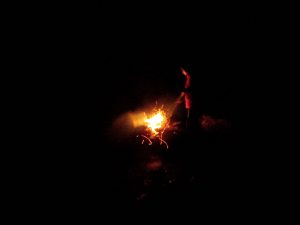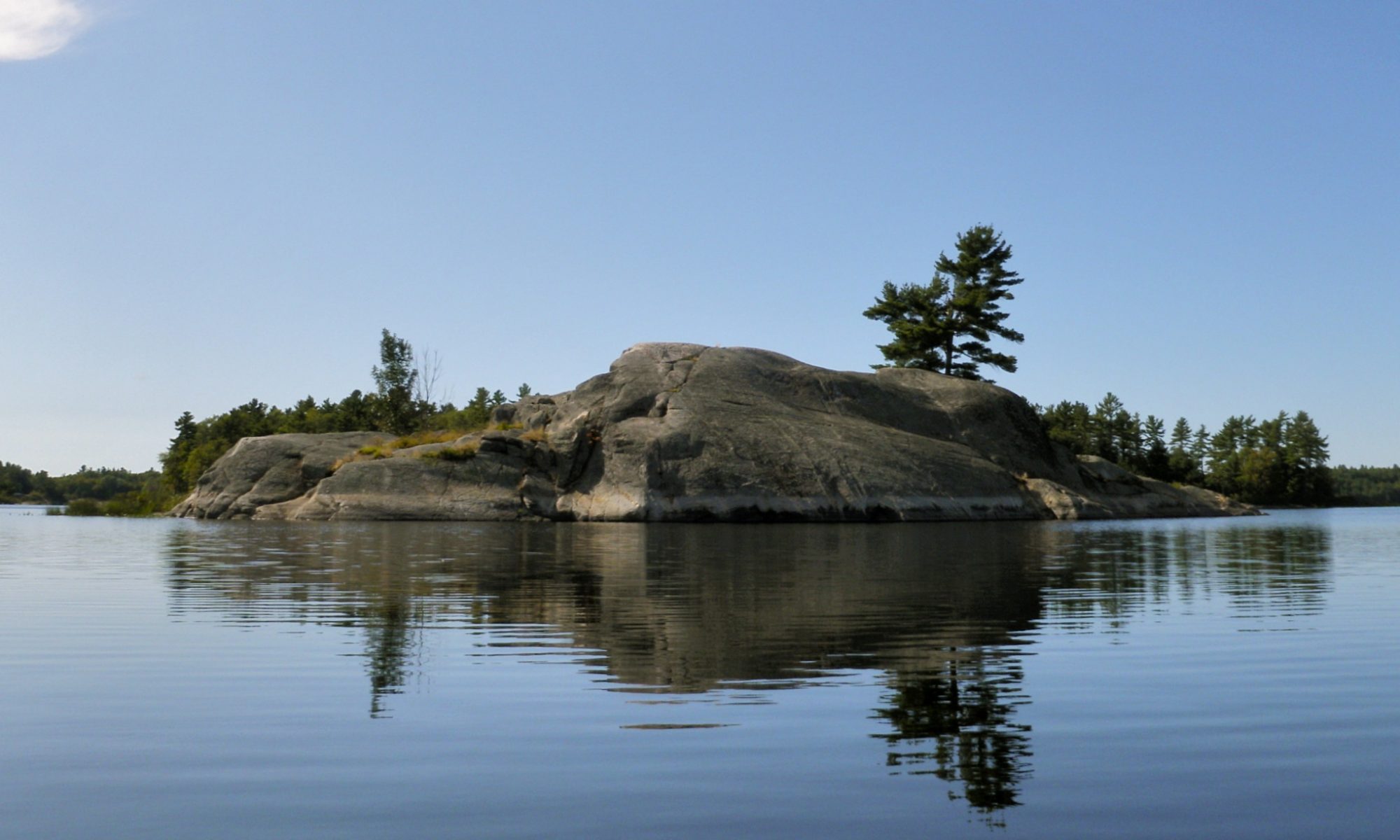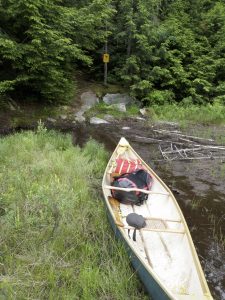My son and I visited the Frost centre for some camping and geocaching on the Nunikani loop. I’d read about the trip in Kevin Callan’s “A Paddler’s Guide To Cottage Country” and it seemed like a nice easy trip to close out the season.
We almost cancelled, because despite booking our site late, seemingly minutes after I made the reservation the weather report turned nasty calling for cold weather, high winds and showers. We arrived at the Big Hawk Lake marina prepared to change our plans, but finally decided to set out despite gray skies, 40 km/h winds and an intermittent drizzle.
Big Hawk And Clear Lakes
Big Hawk Lake was quite rough, but at least the wind was at our backs. In several places the canoe was literally surfing the larger waves, and there were a considerable number of white caps. My hat was blown off twice, once into the water, but I was able to grab it both times. In sharp contrast with the cold air the water was warm to the touch.
We were quite surprised to find large docks at either end of the portage into Clear Lake, serviced by an ATV. It turns out that some poor soul had planned an outside wedding on one of the rocky outcrops in the lake. The area is quite scenic, but the weather was even less suitable for a wedding than for camping.
I was a bit disappointed by the number of cottages we encountered – the shores of all lakes except for Nunikani are encrusted with cottages despite the limited road access, and small power boats and canoes are stashed along the shores in many places.
Red Pine Lake
The portage to red pine lake is quite mucky, but some strategically placed wooden planks make it easier. Callan’s book mentions two portages, but we didn’t see the second one. Red Pine Lake is also very scenic, but when we arrived the far end was clouded in rain, and the winds were fairly strong on the more open areas. We kept to the far east, skirting around the large island to find the No Jumping, No Diving geocache.
After finding the cache we paddled around the north end of the large island. The area between the islands was quite shallow, but we could see whitecaps and a strong current flowing around the north end of the lake so we stuck close to the shore of the island. The wind was still fierce, and as soon as we rounded the corner it took a lot of strength just to keep the canoe moving. We headed straight into the wind, and despite steady progress it felt like we weren’t moving at all.
We were about half way across when a motor boat made a beeline for us and asked if we were ok. Being gluttons for punishment we thanked him but waved him on, and he took off before we could change our minds.
Once we were near the west end of the lake we veered south, only to realize that the dam and portage to Nunikani were to the north. We hugged the shore to keep out of the wind and headed to the north end of the lake where we landed at the dam.
Little Nunikani
The dam was interesting to look at, and we took the portage twice – once with our gear and then again with the canoe. The first 200 – 300 meters are very easy, almost like a paved path, but then the trail gets rougher and muddier. We slipped a few times on wet roots in the rain. The first time we walked the trail we missed the put out point and hiked all the way to the end where there are some lovely rocks. On the way back I spotted the portage sign next to a particularly muddy section of trail, so we only carried the canoe that far, then we ran back to grab our paddles and paddled the boat back down to the rest of our gear.
Paddling down the Kennisis river to Nunikani was quite easy because of the current. Steam was rising off of the warm water, and as the river opened up into the lake in the setting sun we were surrounded by stumps in the water. Apparently when the dam was built it flooded the river to make the lake, so Nunikani isn’t a natural lake – the ghosts of dead forests dot it’s shores and marshes. Thankfully there were no cottages and for the first time it felt like we were in the wilderness.
It was getting dark so we headed quickly to the portage to Little Nunikani. We passed a campsite on the way in and the locals called to us and complained about the wet weather.
The portage to Little Nunikani was very short (just 30m), so we didn’t unload the canoe and hauled it underhand. It was getting dark as we paddled to our campsite (#63) on the far side of our private lake. We just had time to gather firewood and pitch our tents before dark.

We did manage to get our fire going, but never got enough heat to dry out the big logs that would have made a fire warm enough to dry us out and shake the chill out of our bones. The fire was so anemic that we had to cook our burgers and pasta on our Trangia stove. I looked up after lighting the stove and was shocked to see the sky dotted with stars smeared by the cloudy streak of the Milky Way. The clouds had parted overhead, but there was still a haze on the horizon where we could see thunderbolts flashing and hear the occasional echoing boom of thunder. After eating dinner we lay on the rocks to watch the show before doing the dishes.
Nunikani
It rained a couple of times during the night but not enough to penetrate our defences. When I woke around 7 I could see pink clouds and blue sky through the fly of my hammock. I emerged to a glorious sunny morning, but by the time I had dried out my clothes on the rocks and started breakfast the clouds had rolled back in and the rain had started.
I made a botch of breakfast by putting too much water in the mix, so we had to settle for trail mix. Just as we were packing the canoe to head back it started to rain harder and we decided to wait it out. After about 20 minutes we gave in and paddled out in the rain.
Just minutes after we had hauled our canoe through the short portage to Nunikani the rain stopped, the clouds parted and were greeted with a glorious view of this beautiful lake. We paddled slowly to savour this beautiful, wild little lake. Nunikani is small, but beautifully desolate, with no cottages. We did spot some motor boats stashed among the trees, but none of them were on the water.
At the dam we found the Nunikani cache, and then after taking some photos portaged the boat to the bottom of the rapids. The rapids here are very violent and make for an impressive sight.
Big Hawk Cliffs
The river gave us a push again until we we reached a set of very small rapids that wasn’t on my map. Instead of shooting them we opted to carry the canoe, loaded with gear over the rocks. The shore of the river here is dotted with large stumps that have washed ashore, presumably from Nunikani above the dam.
We rounded the final bend of the river to see the tall cliffs that were once rumoured to contain a native gold mine. Nowhere else do the gravely beaches and rugged shores of Nunikani evoke the valleys of the rockies in BC more. We paddled slowly down this majestic pass, only using our paddles to guide the canoe. Even the tiny cottages that dot the base of the cliffs don’t detract from their impact.
Log Chute
Once we were back on Big Hawk Lake we had a very vigorous paddle to round the point to the marina. The wind had died considerably since the day before, but paddling against it was difficult even for such a brief stretch so we stuck very close to shore. Once we were in the bay leading to the marina it was a relatively easy paddle to the beach.
After we tied the canoe to the car we stopped to visit the last log chute in Ontario (and failed to find the cache there) before starting the long drive home.
As promised in Callan’s book Nunikani is a very scenic trip, and under normal conditions would be quite easy. The heavy winds did make some of the paddling more challenging, but still attainable for a determined novice. My only disappointment other than the weather was the number of cottages that dotted the sore of all of the lakes that we visited with the exception of Nunikani.
Tips
The Haliburton Highlands Water Trails are a managed camping area and require a reservation for overnight camping. They have an excellent website for online reservations. Campsites are booked individually rather than by the lake so you know you know that your site will be available if you arrive late.
Difficulty
- This is a short trip and the longest portage is only 440m.
- We had a tough paddle on Red Pine Lake, but I don’t think that was just bad luck.
- The trip can be easily completed in two days.
Comfort
- I visited in the late summer and so understandably there were no bugs. I don’t really know how bad they’d be in the spring.
- The high cliffs on Big Hawk Lake make for some spectacular views which are a bit above other routes in the area.
Remoteness
- There are a lot of cottages on Big Hawk Lake and several more on Clear Lake and Red Pine Lake. The only lake that feels like wilderness is Nunikani and it has large dams at either end.
- The weather and the season conspired to keep the crowds away on our trip, but we still saw quite a few people. Even if you manage to avoid other campers it’s quite likely that the cottager traffic will be quite high.


